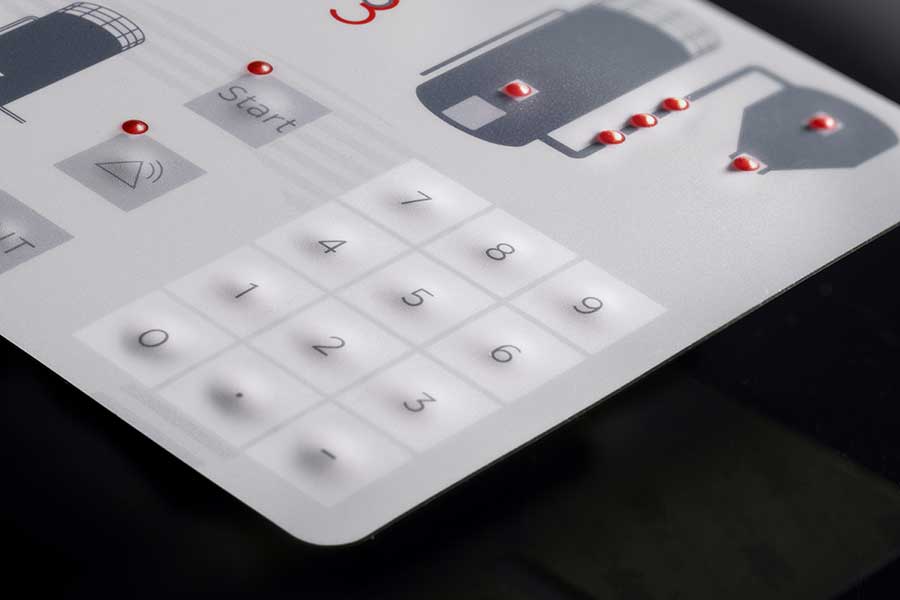Discover Just How a Membrane Switch Improves Longevity and Capability in Tools
Discover Just How a Membrane Switch Improves Longevity and Capability in Tools
Blog Article
Comprehending the Functionality of Membrane Layer Switches for Interface Gadget
The functionality of membrane layer switches over stands for a significant improvement in customer interface layout, combining efficiency with visual versatility. As industries significantly focus on user experience, understanding the nuances of membrane switch modern technology comes to be essential.
What Are Membrane Layer Switches?
Membrane switches are innovative user interface gadgets that help with user interaction with electronic tools. These functional components include numerous layers, including a graphic overlay, spacer, and a published circuit layer. The style permits a seamless combination into different electronic gadgets, enhancing both the aesthetic and practical elements of interface.
Membrane layer switches are typically utilized in a variety of applications, from household devices to commercial equipment and clinical tools. Their building commonly features a thin profile, making them an excellent choice for small styles. The responsive feedback given by these switches can be engineered to meet details user choices, making certain efficient interaction in between the customer and the tool.
Sturdiness is an additional substantial advantage of membrane buttons, as they are immune to dirt, moisture, and chemicals, which improves their life-span sought after environments. Furthermore, these switches can be customized in terms of shape, size, and graphic style, enabling for branding and user-specific features. Generally, membrane layer switches over stand for a practical solution for boosting individual experience in digital tools, integrating performance with visual appeal in an efficient way.
Exactly How Membrane Switches Job
Operating on a straightforward principle, membrane layer switches utilize a split building and construction to sign up user input efficiently. Each button is composed of several layers, consisting of a published circuit layer, a spacer layer, and a leading graphic layer, which are created to collaborate seamlessly. When an individual presses the top layer, it compresses the spacer layer, bringing the conductive aspects of the circuit layer into call with each other.
This call produces a shut circuit, signifying the device to execute a particular function. The layout permits numerous arrangements, including tactile responses, which can boost the individual experience by giving a physical feeling upon activation. The materials used in membrane layer buttons usually consist of versatile substrates, such as polyester or polycarbonate, which ensure durability and durability versus damage.

Secret Benefits of Membrane Layer Buttons

One more significant benefit is their compactness. Membrane buttons are slim and light-weight, which makes it possible for makers to conserve space in their devices without giving up capability. This attribute is especially beneficial in applications where weight and volume are essential factors to dig this consider.
In addition, membrane switches are resistant to dust, moisture, and chemicals, enhancing their resilience. This durability expands their life-span and decreases the demand for constant substitutes, leading to cost financial savings gradually.
Furthermore, the tactile responses offered by membrane layer buttons can be maximized to boost user interaction. They can include attributes such as raised buttons or distinct clicks, enhancing functionality and customer experience.
Applications Across Industries
Interface tools utilizing membrane buttons are common in a broad variety of industries, showcasing their flexibility and capability. Membrane Switch. In the medical industry, membrane layer switches are integral to tools such as diagnostic equipment and individual monitoring systems, where their sturdiness and ease of cleansing are vital for maintaining health standards. In the automobile market, these buttons are employed in control panel controls and infotainment systems, offering a sleek and contemporary interface for users.
Moreover, the consumer electronic devices field gain from membrane buttons in home appliances and portable devices, where small layout and straightforward interfaces boost user experience. Industrial applications also take advantage of membrane switches for control panels in machinery and automation systems, stressing their toughness and resistance to severe atmospheres.
In the aerospace and protection markets, membrane switches are utilized in cockpit controls and tools, where reliability and efficiency under severe problems are vital. In addition, the video gaming market increasingly incorporates membrane layer switches in controllers and gallery machines, adding to an interesting customer experience. Overall, the adaptability of membrane layer switches over enables their extensive usage across many fields, emphasizing their relevance in modern interface layout.
Future Trends in Membrane Layer Switch Over Innovation

In addition, using advanced products, use this link such as polycarbonate and polyester films, is anticipated to climb, offering boosted resilience and resistance to environmental stress factors. These products contribute to the general long life of membrane layer switches, making them appropriate for harsher commercial applications.
Additionally, the incorporation of smart innovation, consisting of IoT connection, will certainly enable membrane layer buttons to communicate with various other tools and systems, go to this website helping with an extra interactive customer experience. This trend aligns with the growing need for smart devices across numerous markets, from healthcare to consumer electronic devices.
Finally, modification alternatives are anticipated to broaden, permitting producers to develop bespoke options tailored to details customer demands and preferences. These advancements will place membrane layer buttons as important components in the development of interface modern technology.
Verdict
In conclusion, membrane layer switches represent a critical development in interface modern technology, providing a reputable and versatile remedy for diverse electronic applications. Their layered construction helps with compact layout, while functions such as responsive feedback enhance user communication. The toughness against environmental elements even more strengthens their energy across numerous industries. As improvements in material science and touch picking up modern technologies continue, the performance and applicability of membrane layer buttons are expected to expand, strengthening their value in contemporary electronic devices.
Report this page